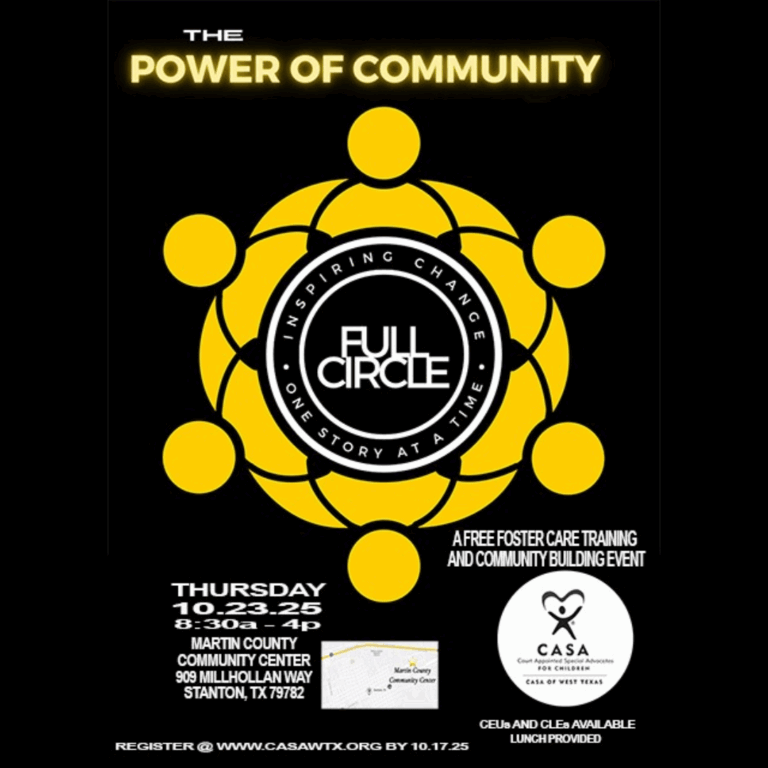Suicide Prevention Month Resources
This information on Suicide Prevention Month was provided by the Texas Department of Family and Protective Services on 08/26/2025. See here.
Suicide prevention starts with recognizing the warning signs of suicide and taking them seriously. Talking openly about suicidal thoughts and feelings can save a life. National and local mental health services, listed below, offer telephone, chat, text and other resources for people who are at risk of suicide. Contact your local mental health authority or call 2-1-1 and ask for the Local Mental Health Authority (LMHA) in your area.
Learn important information on how to help someone who may have suicidal thoughts or feelings. Download the suicide prevention wallet card (PDF) from DFPS it outlines warning signs, practical steps you can take to help and resources for getting professional support.
The 988 Suicide and Crisis Lifeline
- Call or text: 9-8-8
- Chat online: 988lifeline.org
- Support for people who are deaf and hard of hearing: Use your preferred relay service or dial 711 then 988.
Support for Veterans and Their Loved Ones
The Veterans Crisis Line connects veterans in crisis and their families and friends with qualified, caring and confidential support 24/7.
- Call: 9-8-8 and Press 1
- Chat online: veteranscrissline.net
- Send a text message: 838255
- Support for people who are deaf and hard of hearing.
Crisis Text Line
Crisis Text Line provides free; 24/7 crisis support and trains volunteers to support people in crisis.
- Text: TX to 741741 for free, 24/7 crisis support in the U.S.
- Visit: crisistextline.org
Language Matters
Discussing suicide in a neutral and factual manner decreases stigma and encourages others to open up about suicide. Download Language Matters: Talking About Suicide (PDF) for more information about speaking about suicide in a safe and caring manner.
Compassion Fatigue
Compassion fatigue is real and affects people working in the mental health field. Combating compassion fatigue is an important part of suicide prevention. Learn more about the symptoms of compassion fatigue by downloading Compassion Fatigue (PDF).
Parent and Youth Suicide Prevention
It is important for parents to know how to talk to their youth about suicide prevention. To learn about connecting with youth to discuss thoughts of suicide, download the Youth Suicide Prevention (PDF) and Youth Suicide Prevention Wallet Card (PDF).
Suicide Prevention in Schools
It is important for school personnel to know how to talk to their students about suicide prevention. To learn about connecting with students to discuss thoughts of suicide, download the Teacher Youth Suicide Prevention (PDF).
Suicide Prevention Among Youth Involved with the Justice System
Suicide is the leading cause of death among incarcerated youth. If you work with incarcerated youth, learn about the risk factors, warning signs, and protective factors by downloading Suicide Prevention Among Youth Involved with the Justice System (PDF).
Suicide Prevention and Adults in a Correctional Facility
Incarcerated adults are at higher risk of suicide than the general population. To learn more, download the Suicide Prevention and Adults in a Correctional Setting flyer (PDF).
Older Adult Suicide Prevention
Discussions about mental health and checking in with older adults who have experienced a significant loss is important. To learn more, download the Mental Health in Older Adults (PDF) informational flyer.
Care Transitions for People Receiving Suicide Crisis Services
During transitions in care, it is critical for caring professionals, family and friends to maintain contact with the person in care. To learn more, download the Transitions in Care for People Receiving Suicide Crisis Services (PDF) informational flyer.
Suicide Prevention for People with Intellectual and Developmental Disabilities
People with Intellectual and Developmental Disabilities also have thoughts of suicide. To learn more, download the Suicide Prevention for Individuals with IDD informational flyer (PDF).
Suicide Prevention for People with Traumatic Brain Injuries
People who experience traumatic brain injury are at increased risk of suicide. To learn more, download the Traumatic Brain Injury and Suicide Risk flyer (PDF).
Nurse and Clinician Suicide Prevention
Nurses and other clinicians experience high rates of burnout. Compared to the general population, they are at an increased risk of depression, anxiety, and suicide. Learn more about preventing suicide among nurses from the American Nurses Association.
Texas Suicide Prevention Collaborative
Texas Suicide Prevention Collaborative developed the Texas State Plan for Suicide Prevention 2023-2028 and provides free resources, educational information, phone apps and training.
- Visit: texassuicideprevention.org
American Foundation for Suicide Prevention
AFSP has local chapters throughout the state that can deliver education programs to schools, workplaces and communities.
- Visit: afsp.org/our-work/education/
National Alliance on Mental Illness
NAMI is the nation’s largest grassroots mental health organization dedicated to building better lives for the millions of Americans affected by mental illness. Local NAMI chapters can deliver education programs to communities.
- Visit: nami.org
Help Outside the United States
To find a suicide helpline outside the United States, visit:
Provider Resources
Visit our Behavioral Health Services Providers page to find additional information and resources including information on the state suicide prevention programs.


